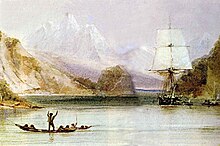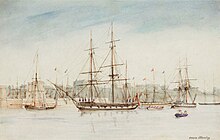HMS Beagle
 HMS Beagle in the Straits of Magellan at Monte Sarmiento, reproduction of R. T. Pritchett's frontispiece from the 1890 illustrated edition of The Voyage of the Beagle.
| |
| History | |
|---|---|
| Ordered | 16 February 1817 |
| Cost | £7,803 |
| Laid down | June 1818 |
| Launched | 11 May 1820 |
| Commissioned | 1820 |
| Decommissioned | 1845, transferred to Coastguard |
| Fate | Sold and broken up 1870 |
| General characteristics | |
| Class and type | Cherokee-class brig-sloop |
| Tons burthen | 235 bm; 242 for second voyage[1] |
| Length | 90.3 ft (27.5 m) |
| Beam | 24.5 ft (7.5 m) |
| Draught | 12.5 ft (3.8 m) |
| Sail plan | Brig (barque from 1825) |
| Complement | 120 as a ship-of-war, 65 plus 9 supernumeraries on second voyage |
| Armament | 10 guns, reduced to 6 guns for first survey voyage, changed to 7 guns during second survey voyage |
HMS Beagle was a Cherokee-class ship of the Royal Navy. It was launched on 11 May 1820 from the Woolwich Dockyard on the River Thames. It is best known for a voyage that carried Charles Darwin.[2]
First voyage (1826–1830)[change | change source]
On 22 May 1826, Beagle left to survey bodies of water in Patagonia and Tierra del Fuego. One of the bodies of water found was named the Beagle Channel after the ship.[3] During the voyage, Captain Pringle Stokes became depressed and shot himself. He died ten days later. Robert FitzRoy became the new captain. Beagle returned to England on 14 October 1830.
Second voyage (1831–1836)[change | change source]

On 27 December 1831, the Beagle began her second voyage.
Captain FitzRoy did not want to have the stress and loneliness that led to the suicide of the first captain. He looked for someone to go on the voyage to keep him company. The person found was Charles Darwin.[4]
On this voyage, the crew did surveys in South America. Beagle returned to Falmouth, Cornwall, England on 2 October 1836.[5]
Darwin kept a diary of the things he saw and did on this voyage. He rewrote it as the book called Journal and Remarks. The book was published in 1839 as the third volume of the official account of the expedition. It was very popular. It was reprinted many times with different titles. It eventually became known as The Voyage of the Beagle.[6]
Third voyage (1837–1843)[change | change source]

In 1837, Beagle went to survey the coast of Australia. Commander John Clements Wickham was in charge. They started with the western coast between the Swan River (modern Perth, Australia) and the Fitzroy River. They then surveyed both shores of the Bass Strait. In May 1839 they sailed north to survey the shores of the Arafura Sea opposite Timor. This voyage ended in 1843.
Many places around the coast were named on this voyage. Many of the places were named for important people or members of the crew. Wickham named Port Darwin in honour of Charles Darwin. A settlement there became the town of Palmerston in 1869, and was renamed Darwin in 1911.[7]
During this survey, the Beagle Gulf was named after the ship.[8]
References[change | change source]
- ↑ FitzRoy 1839, pp. 17–18.
- ↑ Howitt, William (1865). The History of Discovery in Australia, Tasmania, and New Zealand: From the Earliest Date to the Present Day. Longman, Green, Longman, Roberts, and Green. p. 332.
- ↑ Herbert, Sandra (1999). "An 1830s View from Outside Switzerland: Charles Darwin on the "Beryl Blue" Glaciers of Tierra del Fuego". Eclogae Geologicae Helvetiae. pp. 92: 339–346. Retrieved 22 December 2008.
- ↑ Browne & Neve 1989, pp. 4–7
- ↑ FitzRoy 1839, p. 638.
- ↑ R. B. Freeman (1977). "Darwin Online: Journal of Researches". Bibliographical introduction. Retrieved 6 June 2012.
- ↑ "Darwin - Northern Territory - Australia - Travel - smh.com.au". The Sydney Morning Herald. 8 February 2004. Retrieved 22 May 2010.
- ↑ Armstrong, Patrick; All Things Darwin: A-I, Greenwood Publishing Group 2007: "Captain Wickham named the Beagle Gulf, and Port Darwin in what is now Australia's Northern Territory (see Darwin, City of)."
Sources and references[change | change source]
- Darwin, Charles (1989). The Voyage of the Beagle. Penguin. ISBN 978-0-14-043268-8.
- King P.P. (1839). FitzRoy, Robert (ed.). Narrative of the surveying voyages of His Majesty's Ships Adventure and Beagle between the years 1826 and 1836, describing their examination of the southern shores of South America, and the Beagle′s circumnavigation of the globe. Proceedings of the first expedition, 1826-30, under the command of Captain P. Parker King R.N. F.R.S. Vol. I. London: Henry Colburn.
